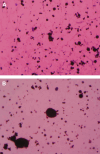First report on the diagnosis and treatment of encephalic and urinary paracoccidioidomycosis in a cat
- PMID: 20471880
- PMCID: PMC10911485
- DOI: 10.1016/j.jfms.2010.03.016
First report on the diagnosis and treatment of encephalic and urinary paracoccidioidomycosis in a cat
Abstract
A male Persian cat was presented with persistent fever, anorexia, weakness, hypopyon, nystagmus, and intention tremors. The hemogram showed severe neutropenia and laboratory analysis on cerebrospinal fluid (CSF) smears revealed abundant yeast cells compatible with Paracoccidioides brasiliensis. Urinalysis demonstrated persistent funguria and an increased urine protein-to-creatinine ratio (UPC) in addition to mild azotemia. Long-term therapy with oral fluconazole was effective in controlling the nervous system signs. Funguria was resolved with subcutaneous administration of diluted amphotericin B in a large volume of saline solution for a period of 12 weeks during the second year after initial diagnosis. Throughout 5 years of treatment, no adverse effects were observed and tolerance to the drugs was normal. Due to development of progressive uremic syndrome the animal was euthanased. To the best of our knowledge, this report is the first clinical case described of a nervous and urinary system infection caused by the P brasiliensis in a cat.
Copyright 2010 ISFM and AAFP. Published by Elsevier Ltd. All rights reserved.
Figures


References
-
- Pereira C., Finotti A., Gollner A., Neumann S., Quesado-Filgueiras M., Curzio M. Paracoccidioidomicose do sistema nervoso central, Arq Neuropsiquiatr 58, 2000, 741–747. - PubMed
-
- Kamei K., Sano A., Kikuchi K., et al. The trend of imported mycoses in Japan, J Infect Chemother 9, 2003, 16–20. - PubMed
-
- Ono M.A., Bracarense A.P., Morais H.S., Trapp S.M., Belitardo D.R., Camargo Z.P. Canine paracoccidioidomycosis: a seroepidemiologic study, Med Mycol 39, 2001, 277–282. - PubMed
-
- Borges-Walmsley M.I., Chen D., Shu X., Walmsley A.R. The pathobiology of Paracoccidioides brasiliensis, Trends Microbiol 10, 2002, 80–87. - PubMed
-
- Borgia G., Reynaud L., Cerini R., et al. A case of paracoccidioidomycosis: experience with long-term therapy, Infection 28, 2000, 119–120. - PubMed
Publication types
MeSH terms
LinkOut - more resources
Full Text Sources
Medical
Miscellaneous

